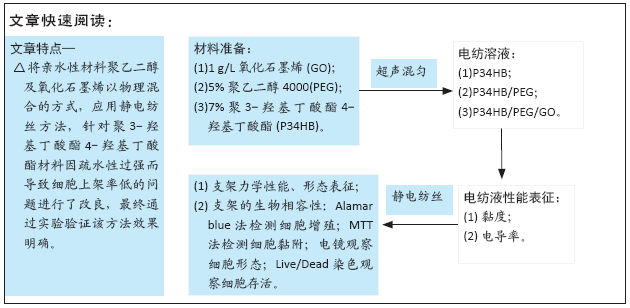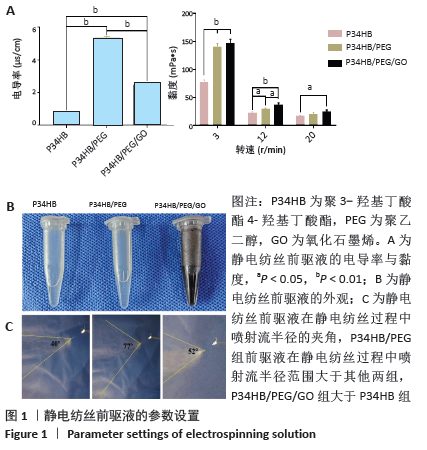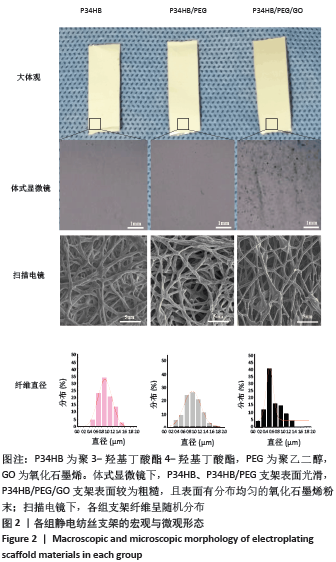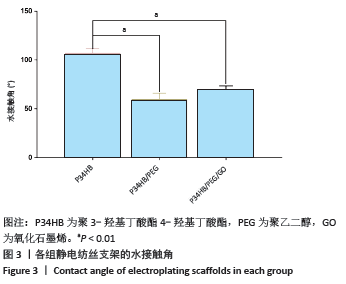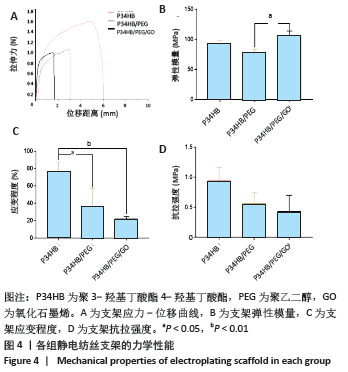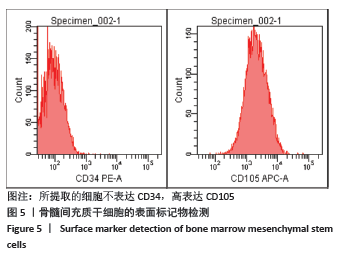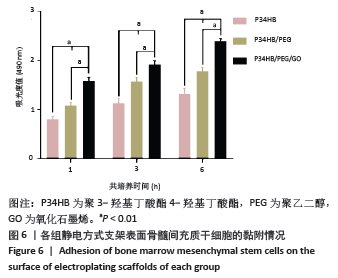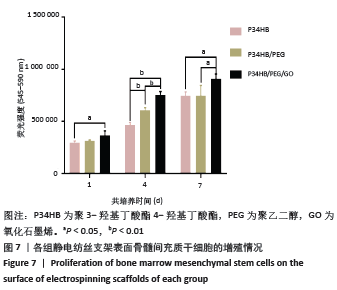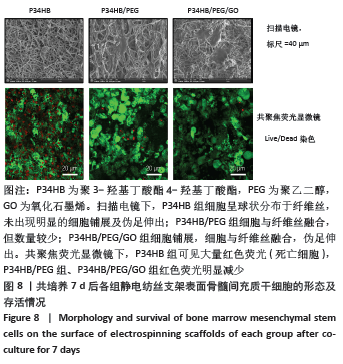[1] STACHEWICZ U, SZEWCZYK PK, KRUK A, et al. Pore shape and size dependence on cell growth into electrospun fiber scaffolds for tissue engineering: 2D and 3D analyses using SEM and FIB-SEM tomography. Mater Sci Eng C Mater Biol Appl. 2019;95:397-408.
[2] FU N, MENG Z, JIAO T, et al. P34HB electrospunfibres promote bone regeneration in vivo. Cell Prolif. 2019;52(3):e12601.
[3] RAMIER J, BOUBAKER MB, GUERROUACHE M, et al. Novel routes to epoxy functionalization of PHA-based electrospun scaffolds as ways to improve cell adhesion. J Polym Sci. 2014;52:816-824.
[4] HE J, TAN W, HAN Q, et al. Fabrication of silk fibroin/ cellulose whiskers-chitosan composite porous scaffolds by layer-by-layer assembly for application in bone tissue engineering. J Mater Sci. 2016;51: 4399-4410.
[5] CUI Z, LIN J, ZHAN C, et al. Biomimetic composite scaffolds based on surface modification of polydopamine on ultrasonication induced cellulose nanofibrils (CNF) adsorbing onto electrospun thermoplastic polyurethane (TPU) nanofibers. J Biomater Sci Polym Ed. 2020;31(5):561-577.
[6] XU F, FAN Y. Electrostatic self-assemble modified electrospun poly-l-lactic acid/poly-vinylpyrrolidone composite polymer and its potential applications in small-diameter artificial blood vessels. J Biomed Nanotechnol. 2020;16(1):101-110.
[7] 刘晓艺,李珊,赵峰,等.微加工技术在细胞形状和排列控制中的应用[J].中国组织工程研究,2017,21(14):2291-2296.
[8] AMOKRANE G, HUMBLOT V, JUBELI E, et al. Electrospunpoly(ε-caprolactone) fiber scaffolds functionalized by the covalent grafting of a bioactive polymer: surface characterization and influence on in vitro biological response. ACS Omega. 2019;4(17):17194-17208.
[9] WU J, CAO L, LIU Y, et al. Functionalization of silk fibroin electrospun scaffolds via BMSC affinity peptide grafting through oxidative self-polymerization of dopamine for bone regeneration. ACS Appl Mater Interfaces. 2019;11(9):8878‐8895.
[10] 鞠晓晶,潘国庆,刘星志,等.可自主结合转化生长因子β1聚乙二醇水凝胶的制备及其生物相容性[J].中国组织工程研究,2018, 22(14):2209-2214.
[11] GAO J, JIANG L, LIANG Q, et al. The grafts modified by heparinization and catalytic nitric oxide generation used for vascular implantation in rats. Regen Biomater. 2018;5(2):105‐114.
[12] COVERDALE BDM, GOUGH JE, SAMPSON WW, et al. Use of lecithin to control fiber morphology in electrospun poly (ɛ-caprolactone) scaffolds for improved tissue engineering applications. J Biomed Mater Res A. 2017;105(10):2865‐2874.
[13] 刘俊,张晓膺.纳米APS外膜肝素化内膜小口径组织工程血管的实验研究[J].上海交通大学学报(医学版),2017,37(3):337-343.
[14] AMINI S, SAUDI A, AMIRPOUR N, et al. Application of electrospunpolycaprolactone fibers embedding lignin nanoparticle for peripheral nerve regeneration: In vitro and in vivo study. Int J Biol Macromol. 2020;159:154-173.
[15] WANG Z, LIANG R, CHENG X, et al. Osteogenic potential of electrospun poly (3-hydroxybutyrate-co-4-hydroxybutyrate)/ poly (ethylene glycol) nanofiber membranes. J Biomed Nanotechnol. 2019;15(6):1280-1289.
[16] YIN PT, SHAH S, CHHOWALLA M, et al. Design, synthesis, and characterization of graphene-nanoparticle hybrid materials for bioapplications.Chem Rev. 2015;115(7):2483-2531.
[17] LEE WC, LIM CH, SHI H, et al. Origin of enhanced stem cell growth and differentiation on graphene and graphene oxide. ACS Nano. 2011; 5(9):7334-7341.
[18] KU SH, PARK CB. Myoblast differentiation on graphene oxide.Biomaterials. 2013;34(8):2017-2023.
[19] ZHOU T, LI G, LIN S, et al. Electrospun poly (3-hydroxybutyrate-co-4- hydroxybutyrate)/ graphene oxide scaffold: enhanced properties and promoted in vivo bone repair in rats. ACS Appl Mater Interfaces. 2017;9(49):42589-42600.
[20] WANG C, HU H, LI Z, et al. Enhanced osseointegration of titanium alloy implants with laser microgrooved surfaces and graphene oxide coating. ACS Appl Mater Interfaces. 2019;11(43): 39470-39483.
[21] CHEN Y, YANG Y, XIAN Y, et al. Multifunctional graphene-oxide-reinforced dissolvable polymeric microneedles for transdermal drug delivery. ACS Appl Mater Interfaces. 2020;12(1):352-360.
[22] 张骏,尤奇,熊华章,等.石墨烯在骨组织工程中的应用[J].中国组织工程研究,2019,23(2):304-309.
[23] MA M, LIU Q, YE C, et al. Preparation of P3HB4HB/ (gelatin + PVA) composite scaffolds by coaxial electrospinning and its biocompatibility evaluation. Biomed Res Int. 2017;2017: 9251806.
[24] 代文杰,王树立,饶永超,等.利用氧化石墨烯促进CO2水合物的生成[J].科学技术与工程,2017,17(3):54-60.
[25] CHEN X, CHEN B. Facile fabrication of crumpled graphene oxide nanosheets and its platinum nanohybrids for high efficient catalytic activity. Environ Pollut. 2018;243(Pt B):1810-1817.
[26] 宋成芝,谢华,胡国新,等.氧化石墨烯对本征石墨烯在天然橡胶基体中的分散促进作用研究[J].功能材料,2019,50(8):8201-8204.
[27] ZHANG C, SALICK MAX R, CORDIE TRAVIS M, et al. Incorporation of poly (ethylene glycol) grafted cellulose nanocrystals in poly (lactic acid) electrospunnanocomposite fibers as potential scaffolds for bone tissue engineering. Mater Sci Eng C Mater Biol Appl. 2015;49:463-471.
[28] LI X, LIU M, CHEN F, et al. Design of hydroxyapatite bioceramics with micro-/nano-topographies to regulate the osteogenic activities of bone morphogenetic protein-2 and bone marrow stromal cells.Nanoscale. 2020;12(13):7284-7300.
[29] MAMINSKAS J, PILIPAVICIUS J, STAISIUNAS E, et al. Novel Yttria-Stabilized Zirconium Oxide and Lithium Disilicate Coatings on Titanium Alloy Substrate for Implant Abutments and Biomedical Application. Materials (Basel). 2020;13(9):E2070.
[30] NIU Y, GUO L, HU F, et al. Macro-microporous surface with sulfonic acid groups and micro-nano structures of PEEK/nano magnesium silicate composite exhibiting antibacterial activity and inducing cell responses. Int J Nanomedicine. 2020;15:2403-2417.
[31] ENGIN P, Ö ZGE E, DILEK K, et al. Clinoptilolite/ PCL-PEG-PCL composite scaffolds for bone tissue engineering applications. J Biomater Appl. 2017;31(20):1148-1168.
[32] PEREZ J, DIMITRIOS K, LI D, et al. Tissue engineering and cell-based therapies for fractures and bone defects. Front BioengBiotechnol. 2018;31(13):96-105.
[33] ZHOU C, LIU S, LI J, et al. Collagen functionalized with graphene oxide enhanced biomimetic mineralization and in situ bone defect repair. ACS Appl Mater Interfaces. 2018;10(50):44080-44091.
[34] MIRZA EH, KHAN AA, AL-KHUREIF AA, et al. Characterization of osteogenic cells grown over modified graphene-oxide-biostable polymers.Biomed Mater. 2019;14(6):065004.
[35] DI CARLO R, ZARA S, VENTRELLA A, et al. Covalent decoration of cortical membranes with graphene oxide as a substrate for dental pulp stem cells. Nanomaterials (Basel). 2019;9(4):604.
[36] MIRZAEI S, KARKHANEH A, SOLEIMANI M, et al. Enhanced chondrogenic differentiation of stem cells using an optimized electrospunnanofibrous PLLA/ PEG scaffolds loaded with glucosamine. J Biomed Mater Res A. 2017;105:2461-2474.
[37] ALIPOUR M, AGHAZADEH M,AKBARZADEH A, et al. Towards osteogenic differentiation of human dental pulp stem cells on PCL-PEG-PCL/zeolite nanofibrous scaffolds. Artif Cells Nanomed Biotechnol. 2019;47: 3431-3437.
[38] LI C, QIAN Y, ZHAO S, et al. Alginate/PEG based microcarriers with cleavable crosslinkage for expansion and non-invasive harvest of human umbilical cord blood mesenchymal stem cells. Mater SciEng C Mater Biol Appl. 2016;64:43-53.
|
